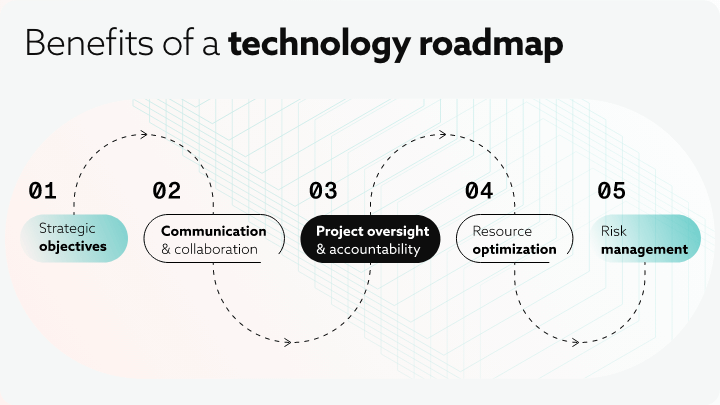Technology keeps advancing every day. The applications on our phones get newer and newer upgrades, while devices that used to be in our day-to-day lives for years get replaced with newer models – some more efficient, and some with more functionalities.
This constant improvement and change is a good thing. Staying in one place is not an option for humanity and it definitely can’t be an option for technology. With all the changes in how we do things and with what we do things, however, there are challenges of keeping up and adapting to the newer trends.
This is especially true in the healthcare industry where everything is changing drastically every day. And having a system that allows us to ease the process of adapting to new conditions is vital. That’s where technology roadmaps come into play.
In this article, we will take a look at the key elements of what makes a good technology roadmap and how this methodology of adaptation to new devices and products can have resounding benefits for the healthcare industry.
What is a technology roadmap?
A technology roadmap, also known as an IT roadmap, serves as a strategic visualization of how technical capabilities evolve to support specific business priorities or industry needs, such as healthcare.
It goes beyond a mere depiction of existing infrastructure, architecture, and processes, extending to articulate plans for enhancements or additions. In the context of healthcare, a system roadmap becomes indispensable when addressing core infrastructure requirements, supporting innovation geared towards growth, and managing technical debt inherent in the rapidly evolving healthcare landscape.
This technology roadmap template functions as a blueprint, outlining the “why,” “what,” and “when” of significant technology investments before delving into the detailed “how” of development and implementation.
It plays a crucial role in aligning highly technical IT initiatives with overarching business goals. The ultimate goal is providing a strategic focus on delivering technology solutions that are not only efficient but also in harmony with the unique demands of healthcare organizations.
Typically, the responsibility of crafting an IT systems roadmap falls on the shoulders of individuals managing technical aspects within an entire organization. This role is commonly assumed by an IT manager, occasionally a technical product manager, or a program manager.
To facilitate this process, many professionals opt for robust roadmapping tools that offer dynamic and detailed views. Alternatively, some prefer to initiate the planning phase using a lightweight whiteboard template, ensuring a swift and efficient mapping of plans.
The scope of IT systems roadmaps can vary significantly, ranging from covering the technical capabilities of a single healthcare product to encompassing an entire portfolio or company. The approach to building a tech roadmap is contingent upon the specific plans and organizational structure within the healthcare sector.
Why do you need technology roadmaps
The significance of technology roadmaps extends beyond general business operations, finding particular importance in complex and resource-intensive sectors such as healthcare. Companies, especially those navigating the intricate landscape of the healthcare industry, require strategic planning for their technological infrastructure to ensure effectiveness, reliability, and alignment with organizational goals.
In healthcare, where new technology implementation plays a pivotal role in patient care, administrative processes, and overall system efficiency, technical roadmaps become indispensable. These roadmaps provide a navigational guide for IT managers and technical leads, offering a clear path for the organization’s desired technology approach.
By doing so, they enhance communication and understanding among key stakeholders and cross-functional teams. This ensures everyone is aligned with the specific requirements needed to achieve desired outcomes in the healthcare domain.
The role of technology as a differentiator is heightened in healthcare, where users seek not only functional products but also demand speed, security, reliability, and modernity. The technology component becomes an integral part of the Complete Product Experience (CPE) in healthcare, influencing patient care, support systems, third-party integrations, and overall organizational policies.
Investing in technology alternatives that facilitate internal teams to achieve more, faster, is critical in healthcare’s digital transformation journey. This transformation, marked by significant technological investments, underscores the heightened importance of technology roadmaps.
These roadmaps become instrumental in guiding healthcare organizations through the complexities of their digital evolution, ensuring a holistic and well-coordinated approach to product development and overall healthcare delivery.
Benefits and challenges of a technology roadmap
Technology roadmaps offer numerous benefits, serving as strategic tools that guide organizations through their technological journey.
Here are the key advantages:
- Strategic objectives: Clear roadmaps ensure that technology initiatives align with the organization’s broader business needs. This alignment prevents disjointed efforts and ensures that technological investments contribute directly to achieving long-term goals.
- Communication and collaboration: An effective roadmap fosters transparent communication and collaboration among all relevant stakeholders, including project managers, development teams, and end-users. This collaboration ensures a shared understanding of project goals, reducing silos and promoting a unified approach in the team’s priorities.
- Project oversight and accountability: With defined timelines and milestones, technology roadmaps provide a framework for monitoring project progress. This oversight allows stakeholders to identify and address issues promptly, preventing project delays and ensuring accountability.
- Resource optimization: Roadmaps assist in effective resource allocation by defining roles, responsibilities, and budget estimates. This optimization prevents resource wastage and enhances overall cost-effectiveness in project management.
- Risk management: Technology roadmaps incorporate risk factors and assessments, allowing organizations to proactively identify and mitigate potential challenges. This risk management approach minimizes the impact of uncertainties on project timelines and objectives.
In essence, well-structured product roadmaps become a strategic tool for changing businesses and guide them through the complexities of digital transformation. At the same time, they maximize the value derived from technology investments.
Key components of how to create a technology roadmap
The key components of building a technology roadmap play a crucial role in guiding organizations through their technological endeavors. Let’s explore each component.
Establishing clear objectives
Clear and well-defined objectives form the foundation of a technology roadmap. This component involves outlining specific goals that the organization aims to achieve through technological advancements. These objectives should align with broader business strategies and provide a roadmap’s purpose and direction.
In the realm of healthcare software, clear objectives could include enhancing patient care through innovative technologies, improving interoperability among healthcare systems, or ensuring compliance with evolving healthcare regulations.
These objectives serve as a compass, guiding the development and implementation of software solutions that directly contribute to the advancement of healthcare services.
Assessing current technological landscape
A comprehensive understanding of the existing systems and system capabilities is also essential.
This involves evaluating current capabilities of the infrastructure, the major systems, and the technologies in use. This assessment provides insights into the organization’s strengths and weaknesses, serving as a starting point for planning future technology needed.
Healthcare organizations often deal with complex and interconnected systems. Assessing the current technological landscape involves evaluating existing Electronic Health Record (EHR) systems, patient management tools, and data analytics platforms.
This assessment helps identify areas for improvement and integration, ensuring that new technology projects and software aligns seamlessly with the existing healthcare IT infrastructure.

Discover how we can help outsource Healthcare projects efficiently
Speak to an expert today, and see how our on-demand IT talent and augmented teams can efficiently deliver value at every step of your roadmap.

Identifying future technological trends
Anticipating and incorporating future technological trends is a critical aspect of the development process.
Organizations must stay abreast of emerging technologies relevant to their industry. Integrating these trends into the product roadmap ensures that the organization remains competitive and can harness the benefits of technological advancements.
A few examples for future trends in healthcare software may include:
- The integration of artificial intelligence for diagnostics;
- Telehealth technologies for remote patient monitoring;
- Blockchain for secure health data management, etc.
Identifying and incorporating these trends into the roadmap ensures that healthcare software remains at the forefront of technological innovation, ultimately enhancing patient outcomes and operational efficiency.
Aligning with business goals
Alignment with the initiatives planned with short-term and long-term business goals is paramount when adding new tools to the tech stack.
Each technological initiative outlined in the roadmap should directly contribute to achieving broader business objectives. This component ensures that technology investments are purposeful and contribute to the overall success and growth of the organization.
For healthcare organizations, business goals often revolve around providing high-quality patient care, improving clinical workflows, and ensuring data security and privacy. A clear roadmap aligned with these goals ensures that healthcare software initiatives directly contribute to the overarching mission of delivering efficient and patient-centric healthcare services.
Collaboration and stakeholder involvement
Collaboration among all your stakeholders is fundamental for successful technology roadmaps.
Involving key stakeholders, including executives, IT teams, developers, product managers, and end-users, fosters a shared understanding of project goals. This collaboration ensures that the team roadmap addresses diverse perspectives and meets the needs of all involved parties.
In healthcare, collaboration among stakeholders is paramount. Involving clinicians, IT professionals, administrators, and even patients in the roadmap development ensures that the new software addresses the diverse needs of the healthcare ecosystem.
Effective collaboration fosters the creation of user-friendly interfaces, seamless integration with clinical workflows, and the delivery of healthcare solutions that resonate with end-users.
Risk assessment and mitigation strategies
Risk assessment is integral to proactive project management. This component involves identifying potential challenges and uncertainties that may hinder the successful implementation of technological initiatives.
Developing mitigation strategies ensures that organizations can address risks promptly and minimize their impact on project timelines.
Healthcare software projects must consider unique risks such as data breaches, compliance challenges, and interoperability issues. Robust risk assessment and mitigation strategies involve anticipating these challenges and implementing measures to safeguard patient data, ensure regulatory compliance, and address potential disruptions to healthcare services.
Implementation and execution plans
Detailed plans for implementation and execution are essential components when planning to implement a new system. This involves outlining the specific steps, milestones, and realistic timelines for each technology initiative.
Clearly defined execution plans facilitate efficient product management and ensure that teams can work cohesively toward achieving the outlined objectives.
Detailed implementation plans in healthcare software roadmaps should account for regulatory compliance timelines, patient data migration strategies, and integration with existing healthcare IT systems.
Well-defined execution plans enable healthcare organizations to implement software solutions efficiently, minimizing disruptions to clinical workflows and ensuring a smooth transition to new technologies.

Deliver a world-class Healthcare project–with high-skilled, seamlessly integrated IT talent
Learn how from our consultants. We work with clients worldwide.
Continuous review and adaptation
The technology landscape is dynamic, requiring continuous review and adaptation. Regularly assessing progress, gathering feedback, and adapting the roadmap based on changing circumstances contribute to the overall success of technology initiatives.
This iterative process ensures that the roadmap remains relevant to the company goals and effective over time.
The dynamic nature of healthcare requires continuous review and adaptation of technology roadmaps. Regularly assessing the impact of healthcare software on patient outcomes, soliciting feedback from healthcare professionals, and adapting the roadmap based on emerging healthcare trends contribute to the ongoing success and relevance of healthcare software initiatives.
In summary, technology roadmaps that incorporate these key components provide organizations with a strategic framework for navigating the complexities of technological evolution. By paving the way for efficient operations, they foster innovation, and help achieve long-term business success.
In a world where healthcare technologies evolve at a rapid pace every single day. Here at BGO we aim to offer a way to adapt better and faster to these changes through the efficiency and effectiveness of technology roadmaps.


















